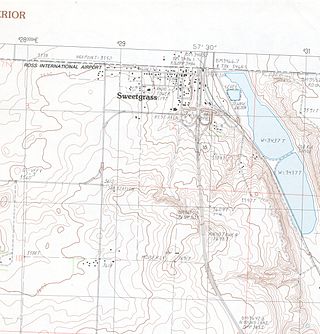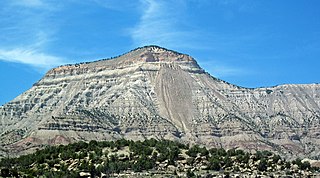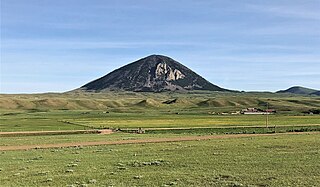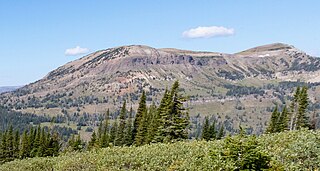
Toole County is a county in the northern portion of the U.S. state of Montana. As of the 2020 census, the population was 4,971. Its county seat is Shelby. The county was established in 1914 from parts of Hill County and Teton County and was named after Joseph Toole, the first and fourth governor of Montana. Its northern boundary is the Canada–United States border south of Alberta.

Bear Butte is a geological laccolith feature located near Sturgis, South Dakota, United States, that was established as a State Park in 1961. An important landmark and religious site for the Plains Indians tribes long before Europeans reached South Dakota, Bear Butte is called Matȟó Pahá, or Bear Mountain, by the Lakota, or Sioux. To the Cheyenne, it is known as Noahȧ-vose or Náhkȯhe-vose, and is the place where Ma'heo'o imparted to Sweet Medicine, a Cheyenne prophet, the knowledge from which the Cheyenne derive their religious, political, social, and economic customs.

Sweet Grass is a census-designated place and unincorporated community in Toole County, Montana, United States, on the Canada–US border. It is the northern terminus of Interstate 15, an important route connecting western Canada, the western United States, and Mexico. The population was 65 according to the 2020 census.

Crested Butte is a prominent mountain summit in the Elk Mountains range of the Rocky Mountains of North America. The 12,168-foot (3,709 m) peak is in Gunnison National Forest, 2.1 miles (3.4 km) northeast by east of the Town of Crested Butte in Gunnison County, Colorado, United States. Ski lifts and runs of the Crested Butte Mountain Resort occupy the north side of the mountain.
Bearmouth is a former town located in Granite County, Montana, USA. It began as a trading post for the placer mining camps of Beartown, Garnet and Coloma, located in the hills north of Bearmouth in Granite County. A pioneer family named Lannen operated the gold exchange and ferry boat across the Clark Fork River.

The Sweet Grass Hills are a small group of low mountains rising more than 3,000 feet (910 m) above the surrounding plains southwest of Whitlash, Montana, in Liberty and Toole County, Montana. The tallest point in the hills is West Butte at 6,983 feet (2,128 m). Quite prominent in the local area, they are clearly visible from US Highway 2 to the south, I-15, and can sometimes be seen as far North as the Crowsnest Highway (Highway 3) near Medicine Hat in Alberta as well as from the West, near Glacier National Park and Browning, Montana. Visibility may vary depending on local air temperatures or heat domes that may increase or decrease the apparent height of the features. Other named peaks in the small group are Gold Butte (6,512 ft [1,985 m]), East Butte, and Mount Lebanon (5,807 ft [1,770 m]). The Sweet Grass Hills are an example of the island ranges that dot the central third portion of the state of Montana. These island ranges, completely surrounded by the 'sea' of plains and not geographically part of the Rocky Mountains to the west, are "biological hotspots", containing more species than the prairie below.

The Regional designations of Montana vary widely within the U.S state of Montana. The state is a large geographical area that is split by the Continental Divide, resulting in watersheds draining into the Pacific Ocean, Gulf of Mexico and Hudson's Bay. The state is approximately 545 miles (877 km) east to west along the Canada–United States border and 320 miles (510 km) north to south. The fourth largest state in land area, it has been divided up in official and unofficial ways into a variety of regions. Additionally, Montana is part of a number of larger federal government administrative regions.

Black Butte, el. 10,547 feet (3,215 m) is the highest peak in the Gravelly Range in Madison County, Montana. The eastern base of the peak is less than 1 mile (1.6 km) from the Beaverhead-Deerlodge National Forest road #290.

Haystack Butte is a 7,486-foot-elevation (2,282-meter) summit located in the Lewis Range, of Glacier National Park in the U.S. state of Montana. It is situated one mile west of the Continental Divide, in Flathead County, above the Weeping Wall on its south slope. Topographic relief is significant as the west aspect rises 3,900 feet above McDonald Creek in less than 1.5 mile. It can be seen from Logan Pass, and from Going-to-the-Sun Road which traverses the west and south slopes of the peak. The nearest higher neighbor is Mount Gould, 1.07 miles (1.72 km) to the northeast. Climbing access is via the Highline Trail. This geographical feature's descriptive name was on maps as early as 1904, and was officially adopted March 6, 1929, by the United States Board on Geographic Names

Mount Logan is an 8,413-foot-elevation (2,564-meter) mountain summit located in Garfield County, Colorado, United States. This peak is situated 5 miles (8.0 km) north of the community of De Beque, and 31 miles (50 km) northeast of Grand Junction. Interstate 70 traverses the southeast base of the mountain. Precipitation runoff from this landform drains into the Colorado River, and topographic relief is significant as the summit rises 3,500 feet above the river in three miles (4.8 km). The mountain and surrounding area is controlled by the Bureau of Land Management. This landform's toponym has appeared in publications since at least 1913, and has been officially adopted by the U.S. Board on Geographic Names.

Mount Lebanon is a 5,807-foot (1,770-metre) mountain summit in Liberty County, Montana, United States.

West Butte is a 6,983-foot-elevation (2,128-meter) mountain summit located in Toole County, Montana, United States.

Mount Brown is a 6,958-foot-elevation (2,121-meter) mountain summit located in Liberty County, Montana, United States.

Fisher Mountain is a 10,246-foot (3,123-metre) summit in Park County, Montana, United States.

Henderson Mountain is a 10,343-foot (3,153-metre) summit in Park County, Montana, United States.

Miller Mountain is a 10,494-foot (3,199-metre) summit in Park County, Montana, United States.

Crown Butte is a 10,225-foot (3,117-metre) summit in Park County, Montana, United States.

Mount Abundance is a 10,116-foot (3,083-metre) summit in Park County, Montana, United States.

Three Dike Hill is a 3,430-foot-elevation (1,045-meter) summit in Presidio County, Texas, United States.

Packsaddle Mountain is a 4,661-foot-elevation (1,421-meter) summit in Brewster County, Texas, United States.






















